Fort Whipple, Arizona
Fort Whipple was a U.S. Army post which served as Arizona Territory's capital prior to the founding of Prescott, Arizona. The post was established by Major Edward Banker Willis in December 1863 [1] at Del Rio Springs just north of today's Chino Valley, Arizona. He led Companies C and F of the 1st California Volunteers and built the post under General Order #27 issued by General James Henry Carleton. The post was named Fort Whipple after Amiel Weeks Whipple, a Civil War military officer and topographical engineer. He served as a brigadier general and was mortally wounded on May 7, 1863 at the Battle of Chancellorsville in Virginia.
| Fort Whipple | |
|---|---|
| Prescott, Arizona | |
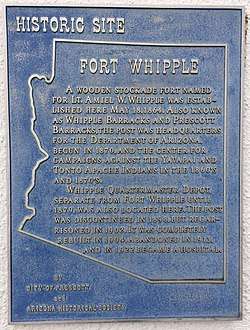 Fort Whipple historic plaque located on the grounds of the VA Hospital in Prescott, Arizona | |
| Type | Army fortification |
| Site information | |
| Controlled by | |
| Condition | Medical treatment facility |
| Site history | |
| Built | 1863 |
| Built by | |
| In use | 1863 - 1913 |
| Garrison information | |
| Occupants | |
On May 18, 1864 Fort Whipple was moved 21 miles south to a miner's tent settlement on the east bank of Granite Creek called Granite City (also Granite Dells, Gimletville), which was on higher ground, had better access to lumber, and the military could better protect miners. The relocation of the fort was recommended by Governor Goodwin. Prescott (approximately two miles west of the fort) was designated as the capital of the Arizona Territory, replacing the temporary capital at Fort Whipple.[2][3]
The old site at Del Rio Springs continued to be used by scouting parties and was called Camp Clark, in honor of John A. Clark, Surveyor General of the New Mexico Territory.
Fort Whipple served as a tactical base for detachments of several regiments involved in the American Indian Wars between 1864 and 1886. The fort became headquarters of the Military Department of Arizona between 1870 and 1886. From May 1885 to July 1886, Fort Whipple was home to Colonel Benjamin H. Grierson and Troop B of the 10th Cavalry Regiment (United States), also known as Buffalo Soldiers. Between 1869 and 1872, the old fort stockade was razed and the majority of new construction occurred up until 1877. The depot, renamed Prescott Barracks in 1878 was merged with Fort Whipple in 1879, and was renamed Whipple Barracks. By 1895, Fort Whipple was dilapidated and in 1897 it was scheduled for deactivation. When the United States declared war on Spain in April 1898, the U.S. Army designated Whipple Barracks to be a point of muster for the Arizona volunteers and reopened on April 29, 1898. 200 volunteers were recruited, called the “Arizona Cowboy Regiment”, they departed on May 4th to assemble in San Antonio, Texas. Officially called the 1st U.S. Volunteer Cavalry, they were nicknamed the Rough Riders and fought in Cuba.
The fort was inactive between 1899 and 1902, then reactivated in April 1902 with plans to rebuild the post. New buildings, barracks and quarters were constructed and completed by 1908. Four companies (about 500 soldiers) moved in. When Arizona became a state in 1912, the fort was determined to be obsolete and troops were relocated to larger forts. Fort Whipple was placed in caretaker status and managed by a small maintenance crew.
In 1918 during World War I, the Army reactivated Fort Whipple as U.S. Army General Hospital #20. The hospital was designated for treatment of soldiers with respiratory illnesses, including tuberculosis (TB) and those injured by nerve gas. It had 22 buildings with plans for up to 1,100 beds.[4]
In 1920, the property was loaned to the U.S. Public Health Service and operated under a permit from the War Department. The hospital continued its mission to treat soldiers and veterans with respiratory illnesses. On April 29, 1922, Executive Order 3669 [5] was signed which then transferred the permit and functions of the hospital to the newly established U.S. Veterans Bureau (Hospital #50, Whipple Barracks, Arizona). In 1931, the U.S. Veterans Bureau was consolidated to become the Veterans Administration (VA) (renamed United States Department of Veterans Affairs in March 1989). In 2004, it was renamed the Bob Stump Department of Veterans Affairs Medical Center, after Congressman Stump, Chairman of the House Armed Services Committee.
Today, known as the Northern Arizona VA Health Care System, the campus retains over twenty of the buildings built during the reconstruction period of 1905-1908. The buildings on the hill originally served as the officers quarters, then served as homes to staff of the hospital for many years. The Department of Veterans Affairs has plans to renovate these former quarters to become useful in providing Veterans with additional healthcare services.[6]
Fort Whipple Museum and other historic structures
Pictured is one of the military officer's quarters (Building 11, painted yellow and green) which has been turned into the Fort Whipple Museum, with artifacts and history about the fort and hospital, including medical instruments, Army weaponry, the Buffalo Soldiers, maps, photographs and memoirs written by those stationed there. The museum is operated as a joint project of the Sharlot Hall Museum and the Bob Stump Veterans Affairs Medical Center.
Also pictured are:
- The Fort Whipple Officer's Row.
- The Fort Whipple NCO Quarters.
- The Fort Whipple Army Barracks.
- The Fort Whipple Post Headquarters.
- The Fort Whipple Theater.
- The Fort Whipple Guardhouse.
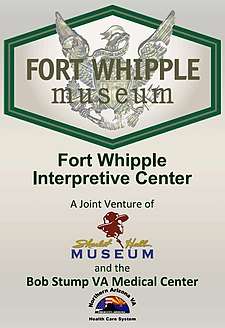
-2.jpg) Fort Whipple Museum (Quarters-11).
Fort Whipple Museum (Quarters-11).-1.jpg) Fort Whipple Museum
Fort Whipple Museum Fort Whipple Officers Quarters.
Fort Whipple Officers Quarters.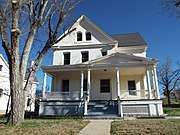 Fort Whipple Officers Quarters in Officer's Row.
Fort Whipple Officers Quarters in Officer's Row.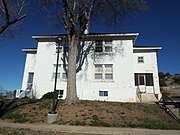 Fort Whipple NCO Quarters.
Fort Whipple NCO Quarters.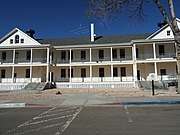 Fort Whipple Army Barracks.
Fort Whipple Army Barracks. Fort Whipple Post Headquarters.
Fort Whipple Post Headquarters. Fort Whipple Theater.
Fort Whipple Theater.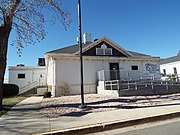 Fort Whipple Guardhouse.
Fort Whipple Guardhouse.
Original location
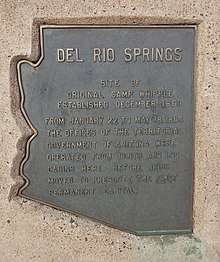
References
- FortWiki
- Brandes, Ray (1959). "A Guide to the History of the U.S. Army Installations in Arizona 1849-1886". Arizona and the West. 1 (1): 42–65. JSTOR 40166912.
- Hoagberg, Earl (May 1999). "135 Years Ago Today a Capital is Born Named Prescott". Sharlot Hall Archives & Library.
- Bates, Al (May 2000). "From Fort to Veteran's Affairs the latest chapter of Whipple". Sharlot Hall Archive & Library. Archived from the original on 2016-10-24. Retrieved 2016-10-24.
- "Executive Order 3669", DocsTeach, National Archives
- "VA's Proposed Use of Historic Properties", Daily Courier, June 27, 2019
External links
- Fort Whipple Museum – A Sharlot Hall Museum and Northern Arizona VA Health Care System Joint Venture
- National Register of Historic Places - Fort Whipple/Department of Veterans Affairs Medical Center Historic District, Prepared by Nancy L. Burgess, Preservation Consultant, October 29, 1999
- Historic Photos, Category - Military, Sharlot Hall Archives & Library.
- The History of Fort Whipple thesis, by Phillip D. Yoder, The University of Arizona, 1951
- Fort Whipple Reconstruction Photos, ca. 1905-1908, Arizona Historical Society Archives
- This Day in History, April 2nd, Fort Whipple, Arizona Memory Project, Arizona Historical Society
- National Register of Historic Places - United States 2nd Generation Veterans Hospitals, Prepared by Cultural Resource Analysts, Inc., October 24, 2011
- Whipple Barracks, Arizona Map, January-March 1909, National Archives Catalog ID# 103396459
- Curtis, Charles A., "Army Life in the West (1862–1865): Civil War Memoir of Charles A. Curtis in New Mexico and Arizona". CreateSpace Independent Publishing Platform, April 20, 2017. ISBN 978-1545458785, 364 pages.
Days Past articles, Sharlot Hall Museum Resource Center
- Remembered Names and Forgotten Faces of Fort Whipple, by Al Bates, Apr 3, 1999.
- Fort Whipple’s Miss Carrie: “The Colonels’ Daughter, by Mick Woodcock, June 19, 1999
- Fort Whipple's Early Days, by Al Bates, July 31, 1999.
- People Before Days of the Empire at Fort Whipple, by Al Bates, November 6, 1999
- Heliographs: The Talking Mirrors of Whipple, Glassford, by James H. Riddle, January 15, 2000
- More on the Talking Mirrors in Yavapai County, by James H. Riddle, January 22, 2000
- The Days of Empire at Fort Whipple, by Al Bates, February 26, 2000
- From Fort to Veteran’s Affairs: The Latest Chapter of Whipple, by Al Bates, May 27, 2000
- Del Rio's Quick Brush with the Seat of Government, by Terry Munderloh, October 14, 2000
- The Fort Whipple Next to Arlington Cemetery?, by Pat Kilkenney, November 18, 2000
- Del Rio Springs after Fort Whipple moved on, by Terry Munderloh, January 13, 2001
- Robert Postle: Officer, Gentlemen, Gambler and Rancher, by Al Bates, May 19, 2001
- Five-Cent Ride Down Gurley Street - Part 1, by Norman Delucchi, June 17, 2006
- Five-Cent Ride Down Gurley Street - Part 2, by Norman Delucchi, June 24, 2006
- Fort Whipple’s Talented Engineer: Lt. Earl D. Thomas, by Tom Collins, September 22, 2007
- Fort Whipple’s First Telegraph: A Turning Point in Prescott’s History, by Tom Collins, May 31, 2008
- Fort Whipple: Territorial Fort to VA Medical Complex – Part 1, by Al Bates, January 14, 2012
- Fort Whipple: Territorial Fort to VA Medical Complex – Part 2, by Al Bates, January 21, 2012
- A Little Known Aspect of Life at Fort Whipple, by Mick Woodcock, May 18, 2013
- The Tenth U.S. Cavalry at Fort Whipple, by John Langellier, June 22, 2013
- Founding Fort Whipple “Set in Motion Machinery of Civil Government”, by Al Bates, December 21, 2013
- The Governor’s Party Reaches Fort Whipple - In Segments, by Al Bates, January 18, 2014
- Arizona Territory’s First Newspaper Begins its Publication at Fort Whipple, by Al Bates, March 8, 2014
- A Frontier Fort on Granite Creek – Part 1, by Mick Woodcock, March 14, 2015
- A Frontier Fort on Granite Creek – Part 2, by Mick Woodcock, March 21, 2015
- New Life for an Old Fort: Instead of Closure, Fort Whipple is Rejuvenated, by Mick Woodcock, May 9, 2015
- Fort Whipple Becomes a Public Health Service Hospital in 1918, by Mick Woodcock, May 16, 2015
- The Final Steps from Frontier Fort to Veterans Hospital, by Mick Woodcock, May 23, 2015
- Charles Leib: Eastern Politician, Territorial Contract Surgeon, by Al Bates, August 15, 2015
- The Arizona Miner: Prescott's First Newspaper, by Fred Veil, September 15, 2018
- Construction Boom at Fort Whipple, 1905-1908, by Worcester P. Bong, September 21, 2019
- The Story Behind the Main Hospital at VA Prescott, 1939, by Worcester P. Bong, February 1, 2020
- If These Gates Could Talk, by Worcester P. Bong, April 4, 2020
- Celebrating National Hospital Day, by Worcester P. Bong, May 9, 2020
- Take a Ride on the Whipple Stage Line, by Worcester P. Bong, August 1, 2020